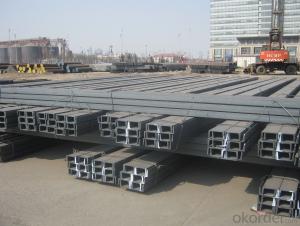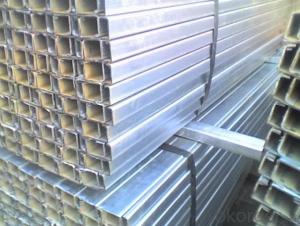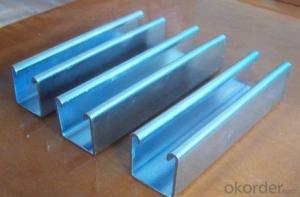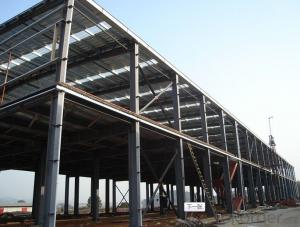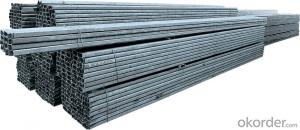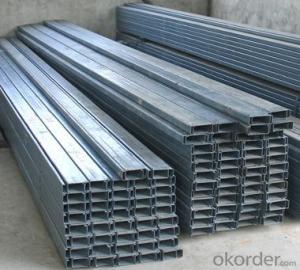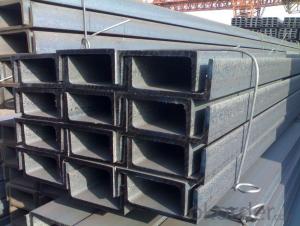Galvanised Strut C Channel AISI,ASTM,BS,DIN,GB,JIS
- Loading Port:
- Guangzhou
- Payment Terms:
- TT OR LC
- Min Order Qty:
- 1000 PCS
- Supply Capability:
- 20000 PCS/month
OKorder Service Pledge
OKorder Financial Service
You Might Also Like
Galvanised C Channel Steel Details
Standard: | AISI,ASTM,BS,DIN,GB,JIS | Dimensions: | 41*21 41*41 41*61 41*82 |
Grade: | Steel.HDG.FRP.ZP,SS304.SS316 | Perforated Or Not: | Is Perforated |
Shape: | C Channel | Application: | construction |
thickness: | 1.5mm 2.0mm,2.5mm 3mm |
Packaging & Delivery
Packaging Detail: | Standard exortation package or as requirement of client |
Delivery Detail: | 10-20 Days |
Galvanised C Channel Steel Performance:
Convenient in construction and save much time and labor
Light and cheap
Length of the product can be manufactured according to customers' requirement
High mechanical strength
Various kinds of fittings can make up of many combinations also for sale
Attractive in appearance
Galvanised C Channel Steel Pictures

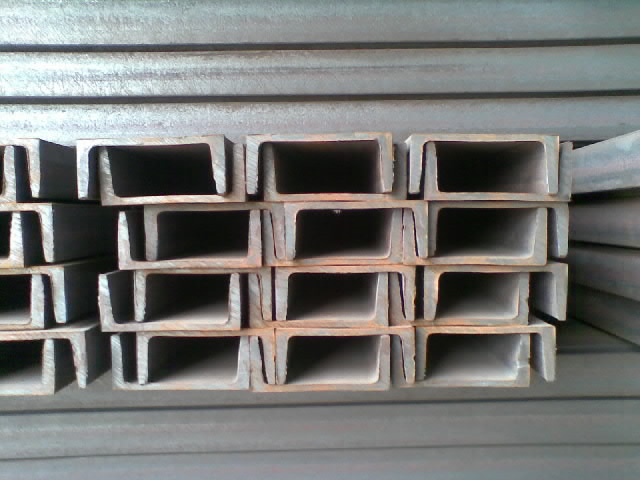
- Q: How do steel channels contribute to natural ventilation?
- Natural ventilation can be enhanced by steel channels in various ways. Firstly, these channels can be utilized to construct air vents or openings within buildings. These openings allow fresh air to enter the building, promoting air circulation and eliminating stagnant air, thus improving the quality of indoor air. To optimize airflow and establish a natural air current, strategic placement of the channels is imperative. Furthermore, steel channels can be employed to fashion louvers or slats in windows or facades. These louvers enable adjustable ventilation, enabling individuals to regulate the amount of air entering the building based on their preferences. By manipulating the position of the louvers, the airflow can be directed towards specific areas or rooms, providing targeted ventilation in areas where it is most needed. Moreover, steel channels can be utilized to construct chimneys or exhaust vents. These structures aid in expelling hot air, smoke, and other pollutants from the building, creating a healthier and more comfortable indoor environment. By generating a vertical airflow, the channels facilitate the dissipation of accumulated heat and enhance air circulation, which is particularly advantageous in spaces with high humidity or where unpleasant smells and contaminants may be present. In summary, steel channels play a vital role in facilitating natural ventilation by providing openings, louvers, and exhaust vents that promote the movement of air. By harnessing natural forces like wind and thermal buoyancy, these channels contribute to the development of a sustainable and energy-efficient ventilation system that enhances the comfort and well-being of building occupants.
- Q: How long do steel channels typically last?
- Steel channels typically have a long lifespan and can last for several decades, depending on various factors such as the quality of the steel, the environmental conditions it is exposed to, and the level of maintenance and care it receives. In general, steel channels are known for their durability and resistance to corrosion, making them highly suitable for a wide range of applications in construction and industrial settings. With proper installation and regular inspections, steel channels can easily last 30 to 50 years or even longer. However, it is important to note that factors such as exposure to harsh chemicals, extreme temperatures, and heavy loads can affect the lifespan of steel channels. Therefore, it is crucial to follow recommended maintenance practices and ensure proper protection to maximize their longevity.
- Q: How do steel channels perform in seismic conditions?
- Steel channels perform well in seismic conditions due to their high strength and flexibility. The structural properties of steel make it resilient to ground motion, allowing channels to absorb and dissipate seismic energy. Additionally, steel's ductility helps channels withstand deformation without catastrophic failure, enhancing their overall performance in earthquake-prone areas.
- Q: Can steel channels be used for retaining walls?
- Yes, steel channels can be used for retaining walls. Steel channels offer several advantages for retaining walls, including their high strength, durability, and resistance to corrosion. They are capable of withstanding heavy loads and can be easily customized to meet specific design requirements. Additionally, steel channels provide a long-lasting solution for retaining walls and can be used in a variety of applications, such as commercial, industrial, and residential projects. However, it is important to consider factors such as soil conditions, drainage, and engineering requirements when selecting and designing a steel channel retaining wall to ensure its effectiveness and stability.
- Q: Are steel channels suitable for use in the construction of storage racks?
- Yes, steel channels are suitable for use in the construction of storage racks. Steel channels are commonly used in the construction industry due to their strength and durability. They provide excellent support and stability for storage racks, allowing them to hold heavy loads without bending or warping. Additionally, steel channels can be easily customized to fit specific storage needs, making them a versatile choice for constructing storage racks. The corrosion resistance of steel also ensures that the racks will last for a long time, even in harsh environments. Overall, steel channels are a reliable and suitable option for use in the construction of storage racks.
- Q: Overhanging Scaffold; channel spacing
- Placement of the cantilever beam, welding rod base, since the corner in order to both sides of the bottom vertical pole, bottom and vertical sweeping bar buckle is fixed, installed in the horizontal sweep shot, and is fixed with a vertical rod, each side up 3--4 pole, then installed the first step (longitudinal flat bar and the vertical and lateral buckling) fixed flat bar (a small bar, near the pole and longitudinal vertical rod fastening fixed). To correct the vertical and horizontal lever of the upright pole to meet the requirements, tighten the fastening bolts according to the 45--55N & M force to form the initial section of the frame, and then extend forward in accordance with the above requirements until the first step of the rack is completed. After crossing the circle, the quality of the structure shall be thoroughly checked, and the design requirements and the quality of the frame shall be strictly ensured. The end wall parts shall be provided, and the second and third steps shall be erected according to the operation procedures and requirements of the first step...... In accordance with the erection process and the fashion set, the wall piece and the scissors support are provided with a work layer, a cross bar, a foot board and a work layer railing, a foot blocking board and a close mesh net.
- Q: What factors should be considered when selecting steel channels?
- To ensure the appropriate choice for the intended application, it is necessary to take several factors into account when selecting steel channels. Firstly, the material grade of the steel channels should be considered. Different grades of steel offer varying levels of strength, durability, and corrosion resistance. The specific requirements of the application, such as load-bearing capacity and exposure to environmental conditions, will determine the suitable material grade. The size and dimensions of the steel channels must align with the project's requirements. This encompasses the height, width, and thickness of the channel, which will determine its load-bearing capacity and structural stability. The shape and design of the steel channels should be chosen based on the specific application and structural requirements. There are various options available, including C-channels, U-channels, and miscellaneous channels. C-channels are commonly used for structural support, while U-channels are often employed for framing and edging purposes. The manufacturing standards and certifications of the steel channels should be carefully considered. Opt for channels that comply with recognized industry standards to ensure their quality, consistency, and suitability for the intended application. The surface finish of the steel channels can impact their appearance, corrosion resistance, and ease of maintenance. Choose between options such as hot-dip galvanized, powder coated, or mill-finished channels. The choice should be based on the project's aesthetic requirements and the level of protection needed against corrosion. Cost-effectiveness is an important factor to evaluate. Compare the prices of different steel channels against their performance, quality, and longevity. Choosing the cheapest option may compromise the long-term performance and durability of the channels. Lastly, consider the reputation and reliability of the supplier. Ensure they have a track record of delivering high-quality steel channels and providing excellent customer support. This includes factors such as on-time delivery, technical expertise, and after-sales service. By considering these factors, one can make an informed decision when selecting steel channels that fulfill the project's requirements in terms of strength, durability, compatibility, and cost-effectiveness.
- Q: What are the environmental benefits of using steel channels?
- Steel channels offer several environmental benefits: 1. Recyclability: Steel is highly recyclable, allowing for infinite recycling without any loss in quality. By using steel channels, we help reduce the demand for raw materials and the energy needed for extraction and production. 2. Energy efficiency: Steel channels are commonly used in construction and infrastructure projects due to their high strength-to-weight ratio. This means less material is required for structural integrity, reducing overall weight and energy needed for transportation and installation. 3. Durability and longevity: Steel is incredibly durable, withstanding extreme weather, corrosion, and pests. The long lifespan of steel channels minimizes the need for frequent replacements or repairs, reducing waste and environmental impact. 4. Reduced carbon footprint: Compared to materials like concrete or aluminum, steel channel production emits fewer greenhouse gas emissions. Advancements in manufacturing techniques have made steel production more sustainable and energy-efficient, further reducing its carbon footprint. 5. Fire resistance: Steel is a non-combustible material, making it a safer choice for construction in terms of fire resistance. The use of steel channels enhances fire safety and reduces the potential environmental impact of fire incidents. Overall, steel channels contribute to environmental sustainability by promoting recycling, conserving energy, minimizing waste, reducing carbon emissions, and enhancing fire safety.
- Q: How do steel channels perform in terms of thermal insulation?
- Steel channels do not perform well in terms of thermal insulation. Steel is a good conductor of heat, so steel channels tend to transfer heat easily. Consequently, they are not effective in providing insulation against heat transfer.
- Q: The role of channel?
- Channel steel is a kind of carbon structural steel used for construction and machinery. It is a complex section steel. Its cross section has a groove shape. Channel steel is mainly used in building structure, curtain wall engineering, mechanical equipment and vehicle manufacturing, etc.. In use, it requires better welding, riveting performance and comprehensive mechanical properties.
Send your message to us
Galvanised Strut C Channel AISI,ASTM,BS,DIN,GB,JIS
- Loading Port:
- Guangzhou
- Payment Terms:
- TT OR LC
- Min Order Qty:
- 1000 PCS
- Supply Capability:
- 20000 PCS/month
OKorder Service Pledge
OKorder Financial Service
Similar products
Hot products
Hot Searches
Related keywords










